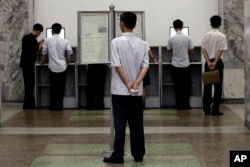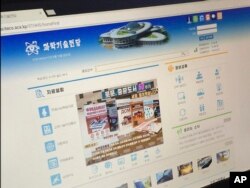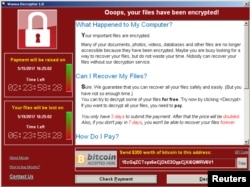Slowly, North Korea is entering the online world.
Thanks to technology, North Korean doctors can talk to patients through online video conferencing. Speeches given at Kim Il Sung University in Pyongyang, the capital, can be seen at faraway factories. North Koreans send text messages to each other on their smartphones. People are even buying products and doing their banking online.
Yet North Korea is still among the least internet-friendly countries on Earth. For most citizens, having a connection to the World Wide Web is unimaginable. Hardly anyone has a personal computer or an email address that is not shared.
But for Kim Jong Un, the country’s first leader to grow up in the internet age, the idea of a more wired North Korea is also appealing. It comes with the promise of new forms of social and political control, and the possibility of cyber-attacks on the West.
The North Korean government’s solution is a two-level system where the upper class can use the internet more freely while others use a national intranet. The intranet system is cut off from the outside world and closely watched by the government.
Using the intranet in North Korea
Pak Sung Jin is a 30-year-old postgraduate student in chemistry. He goes to the Sci-Tech Complex, on Ssuk Island, to do his school work. The large building, a science and technology center, houses North Korea’s largest e-library. It has more than 3,000 computers where people can do research or study subjects.
Pak has some experience with the internet, but on a supervised, need-only basis. If he needs anything from the World Wide Web, university officials will find it for him.
One recent day, Pak used North Korea’s national intranet called “Kwangmyong.” An official at the Sci-Tech Complex said the intranet has 168 sites. Pak also uses a browser called “Naenara”, which means “my country” in Korean. It is like a version of FireFox, except only North Koreans can use it.
North Korea’s national intranet is unusual, even compared to other countries with internet restrictions. Countries like China and Iran, for example, control what their citizens see online, but through censorship and blocking, not complete separation.
A protected system
Most North Korean computers use the “Red Star” operating system, developed from Linux open-source coding.
Red Star 3.0 has the usual software like the Naenara browser, email, and even “kPhoto”. Many of the programs look like Apple products.
Any attempt to change its operations or remove virus checkers results in the computer restarting. Files downloaded from USBs are marked so that officials can identify criminal activity. This prevents the spread of information from other countries.
Red Star also takes screenshots of what is being shown on computer screens. The images cannot be removed and are only available to trained government officials.
Nat Kretchun is with the U.S. government-financed Open Technology Fund. He says the software in Red Star and the mobile operating systems of phones and tablets show a new way for the North Korean government to control information.
In the past, information in North Korea was mainly controlled through government agents, such as the State Security Ministry’s “thought police.” But in the internet age, North Korean officials have learned to use online devices as another tool for gathering information.
North Korean smartphones
The most common online experience for North Koreans is on a smartphone.
Ten years ago, only a small number of military officials had such devices. Now, the main phone provider says there are 2.5 to 3 million mobile phones in North Korea, a country of 25 million people.
The spread of mobile phones is one of the biggest success stories during the rule of Kim Jong Un. It began in 2008 under former leader Kim Jong Il, and has risen quickly over the past five years.
It is easy for North Koreans to buy telephones, but the phones must be registered and approved. With local phones, North Koreans are able to call, text, play games, go on the national intranet, and use other services.
But they cannot receive or make calls to numbers outside that network. Wi-fi use is also banned for North Koreans.
Foreigners in North Korea must use a different system and cannot make calls to, or receive calls from, local numbers. They can buy local phones if they want, but the apps and normal software will be removed. It will also be coded so that the apps cannot be added later.
Internet access for cyber-attacks
While blocking most North Koreans from the internet, the government gives access to a small group of people, including North Korean leaders and the upper-class.
There is strong evidence that the government gives people involved in cyber-attacks the access they need.
U.S. officials say the North launched the WannaCry attack, which infected hundreds of thousands of computers in May and damaged parts of Britain’s National Health Service.
North Korean hackers have been linked to attacks on the Bangladeshi central bank last year and on South Korean banks going back to 2013. There was also the 2014 hack of Sony Pictures over the release of the “Interview,” a film dealing with a plot to kill Kim Jong Un.
The North Korean government has denied hacking accusations.
Beau Woods of the Cyber Statecraft Initiative at the Atlantic Council warned that a more cyber-active North Korea could be very dangerous.
Eric Talmadge reported this story for the Associated Press. Phil Dierking adapted his report for VOA Learning English. George Grow was the editor.
What is internet access like in your country? We want to hear from you. Write to us in the Comments Section or on our Facebook page.
_____________________________________________________________
Words in This Story
censorship – n. the suppression or prohibition of any parts of books, films, or new reports that are considered politically unacceptable or a threat to security.
code – v. to write a computer program
basis – n. something on which something else is based
cyber – adj. relating to the culture of computers and information technology
e-learning – n. learning through electronic media, usually on the Internet
intranet – n. a local or restricted communications system, especially a private network created using World Wide Web software
Linux – n. an open-source operating system
online – adj. controlled by or connected to another computer or to a network
feature – n. a part or the appearance of something












